Facies-Controlled Sedimentary Distribution and Hydrocarbon Control of Lower Cretaceous Source Rocks in the Northern Persian Gulf
Abstract
:1. Introduction
- (1)
- The two phases of source rocks in the Persian Gulf region exhibit significant differences in depositional environments, lithofacies types, and associations;
- (2)
- Multiple transgression events during the evolution of the Neo-Tethyan Ocean played a decisive role in the organic matter enrichment and spatial distribution of the source rocks;
- (3)
- The input of terrestrial materials and the synergistic effects of sedimentary facies belts jointly control the hydrocarbon generation potential of the source rocks in the region.
2. Geological Background
- (1)
- Late Jurassic–Early Cretaceous (Late Tithonian–Berriasian, approximately 129–140 Ma).
- (2)
- Late–Early Cretaceous (Aptian–Albian, approximately 90–110 Ma)
3. Materials and Methods
4. Results and Discussion
4.1. Climate Evolution and Determination of Hydrocarbon Generation Periods Following the Formation of the Neo-Tethys Ocean
4.2. Evolution of the Neo-Tethys Ocean and Paleogeographic Filling Patterns
4.3. Distribution and Characteristics of Source Rocks
4.4. Hydrocarbon Control Mechanisms
5. Conclusions
- (1)
- The organic matter content, type, and thermal evolution of the Late Tithonian–Berriasian source rocks are mainly controlled by sedimentary facies, with the intrashelf basin facies outperforming the shelf facies;
- (2)
- The characteristics of the Aptian–Albian source rocks are primarily regulated by terrestrial input, with the quality of basin source rocks in terrestrial input areas being significantly better than those in non-terrestrial input areas and contemporaneous shelf source rocks, highlighting the critical role of terrestrial input in improving source rock quality.
Supplementary Materials
Author Contributions
Funding
Data Availability Statement
Conflicts of Interest
References
- He, Z.; Jin, Z.; Li, S.; Bai, G.; Lv, X.; Guo, J.; Gao, J.; Yin, J.; Li, Y.; Zheng, D. Prototypes, Modifications, and Hydrocarbon Enrichment Variations in Basins Influenced by Tethyan Evolution: A Comparative Analysis of the Persian Gulf Basin and the Sichuan Basin. Sci. China Earth Sci. 2023, 66, 2871–2897. [Google Scholar] [CrossRef]
- Luo, B.; Zhang, Q.; Duan, H.; Lv, M.; Bian, C.; Zhang, N.; Yang, P.; Wang, N. Sedimentary Response of Cretaceous Tectonic Evolution in the Middle East Rub Al Khali Basin and Its Inspirations for Oil Exploration. China Pet. Explor. 2020, 25, 115–124. [Google Scholar]
- Wang, H.; Li, J.; Sun, W.; Li, W. Global Palaeo-Plate Reconstruction and Lithofacies Palaeogeography in the Silurian. J. Palaeogeogr. 2016, 18, 185–196. [Google Scholar]
- Al-Husseini, M.I. Jurassic Sequence Stratigraphy of the Western and Southern Arabian Gulf. GeoArabia 1997, 2, 361–382. [Google Scholar] [CrossRef]
- De Keyser, T.L.; Kendall, C.G. Jurassic and Cretaceous Sedimentary Fill of Intrashelf Basins of the Eastern Margin of the Arabian Plate. In Proceedings of the 2014 AAPG Annual Convention and Exhibition, Houston, TX, USA, 6–9 April 2014. [Google Scholar]
- Al-Mojel, A.; Razin, P.; Dera, G. High-Resolution Sedimentology and Sequence Stratigraphy of the Oxfordian-Kimmeridgian, Hanifa, Jubaila and Arab Outcrops along Jabal Tuwaiq, Central Saudi Arabia. J. Afr. Earth Sci. 2020, 165, 103803. [Google Scholar] [CrossRef]
- Wolpert, P.; Bartenbach, M.; Suess, P.; Rausch, R.; Aigner, T.; Nindre, L. Facies Analysis and Sequence Stratigraphy of the Uppermost Jurassic–Lower Cretaceous Sulaiy Formation in Outcrops of Central Saudi Arabia. GeoArabia 2015, 20, 67–122. [Google Scholar] [CrossRef]
- Schlagintweit, F.; Yazdi-Moghaddam, M.; Simmons, M. The Palorbitolinoides Event in the Kazhdumi Formation of Southwest Iran and Equivalent Strata of the Arabian Plate: An Expression of the K100 Middle Albian Transgression. Mar. Micropaleontol. 2022, 176, 102169. [Google Scholar] [CrossRef]
- Wang, H.; Liu, B.; Shi, K.; Liu, X.; Han, B. Characteristics of Tectonic-Sedimentary Evolution from Jurassic to Cretaceous in Iraq-Iran Area. Lithol. Reserv. 2021, 33, 39–53. [Google Scholar]
- van Buchem, F.S.; Pittet, B.; Hillgärtner, H.; Grötsch, J.; Al Mansouri, A.I.; Billing, I.M.; Droste, H.H.; Oterdoom, W.H.; van Steenwinkel, M. High-Resolution Sequence Stratigraphic Architecture of Barremian/Aptian Carbonate Systems in Northern Oman and the United Arab Emirates (Kharaib and Shu’aiba Formations). GeoArabia 2002, 7, 461–500. [Google Scholar] [CrossRef]
- Al-Ameri, T.K. Khasib and Tannuma Oil Sources, East Baghdad Oil Field, Iraq. Mar. Pet. Geol. 2011, 28, 880–894. [Google Scholar] [CrossRef]
- Al-Ameri, T.K.; Al-Temimi, A.K.; Zumberge, J. Assessments of Oil Characterization, Source Affinities, and Hydrocarbon Dynamics of East Baghdad Oil Fields, Central Iraq. Mar. Pet. Geol. 2016, 77, 353–375. [Google Scholar] [CrossRef]
- Edilbi, A.N.F.; Sherwani, G.H. Petrography and Source Rock Potential of Chia Gara Formation (Late Jurassic–Early Creta-ceous) in Northern Iraq and Kurdistan Region. J. Pet. Explor. Prod. Technol. 2019, 9, 1801–1818. [Google Scholar] [CrossRef]
- Hosseiny, E.; Mohseni, A. Garau Formation as an Unconventional Hydrocarbon Resource in Southwestern Iran: A Geo-chemical Investigation. J. Pet. Explor. Prod. Technol. 2023, 13, 1535–1549. [Google Scholar] [CrossRef]
- Vahrenkamp, V.C.; Van Laer, P.; Franco, B.; Celentano, M.A.; Grelaud, C.; Razin, P. Late Jurassic to Cretaceous Source Rock Prone Intra-Shelf Basins of the Eastern Arabian Plate—Interplay between Tectonism, Global Anoxic Events and Carbonate Platform Dynamics. In Proceedings of the International Petroleum Technology Conference, Doha, Qatar, 6–9 December 2015. IPTC-18470-MS. [Google Scholar]
- Xi, D.; Xiao, Z.; Zhou, Z. The Global Warming Process and Terrestrial Biota Responded during Early to Mid Cretaceous Period (late Valanginian–early Turonian). Quat. Sci. 2024, 44, 1174–1187. [Google Scholar]
- Zeinalzadeh, A.; Moussavi-Harami, R.; Mahboubi, A.; Sajjadian, V.A. Source Rock Potential of the Early Cretaceous Intervals in the Darquain Field, Abadan Plain, Zagros Basin, SW Iran. Geosci. J. 2018, 22, 569–580. [Google Scholar] [CrossRef]
- Alizadeh, B.; Khani, B.; Alipour, M.; Shayesteh, M.; Hosseini, S.H. Thermal Modeling and Organic Geochemical Appraisal of Petroleum Source Rocks within the Aghajari Oilfield, SW Iran. JGeope 2012, 2, 1–10. [Google Scholar]
- Al-Ameri, T.K.; Al-Marsoumi, S.W.; Al-Musawi, F.A. Crude Oil Characterization, Molecular Affinity, and Migration Pathways of Halfaya Oil Field in Mesan Governorate, South Iraq. Arab. J. Geosci. 2014, 8, 7041–7058. [Google Scholar] [CrossRef]
- Alipour, M. Organic Facies and Paleo-Depositional Environments of the Aptian–Albian Kazhdumi Source Rock in the Zagros Basin of Iran. Mar. Pet. Geol. 2022, 145, 105887. [Google Scholar] [CrossRef]
- Bahrehvar, M.; Mehrabi, H.; Rahimpour-Bonab, H. Coated Grain Petrography and Geochemistry as Palaeoenvironmental Proxies for the Aptian Strata of the Southern Neo-Tethys Ocean, Persian Gulf, Iran. Facies 2020, 66, 3. [Google Scholar] [CrossRef]
- Ibrahim, M.I.A.; Al-Hitmi, H.H.A.; Kholeif, S.E. Albian-Cenomanian Palynology, Paleoecology and Organic Thermal Maturity of Well DK-B in the Dukhan Oil Field of Western Qatar. GeoArabia 2000, 5, 483–508. [Google Scholar] [CrossRef]
- Rahmani, O.; Aali, J.; Mohseni, H.; Rahimpour-Bonab, H.; Zalaghaie, S. Organic geochemistry of Gadvan and Kazhdumi formations (Cretaceous) in South Pars field, Persian Gulf, Iran. J. Pet. Sci. Eng. 2010, 70, 57–66. [Google Scholar] [CrossRef]
- Sefidari, E.; Amini, A.; Dashti, A. Source rock characteristics of Albian Kazhdumi formation in Zagros region. Arab. J. Geosci. 2015, 8, 8327–8345. [Google Scholar] [CrossRef]
- Sfidari, E.; Zamanzadeh, S.M.; Dashti, A.; Opera, A.; Tavakkol, M.H. Comprehensive Source Rock Evaluation of the Kazhdumi Formation, in the Iranian Zagros Foldbelt and Adjacent Offshore. Mar. Pet. Geol. 2016, 71, 26–40. [Google Scholar] [CrossRef]
- Vahrenkamp, V.C. Chemostratigraphy of the Lower Cretaceous Shu’aiba Formation: A δ13C Reference Profile for the Aptian Stage from the Southern Neo-Tethys Ocean. 2010. Available online: https://www.researchgate.net/publication/281543991_Chemostratigraphy_of_the_Lower_Cretaceous_Shu’aiba_Formation_A_13C_reference_profile_for_the_Aptian_Stage_from_the_southern_Neo-Tethys_Ocean (accessed on 13 March 2025).
- Xin, S.; Xie, N.; Zhang, X.; Li, Y.; Zhu, Y. Source Rock Characteristics in the Persian Gulf Basin and Their Control over Hydrocarbon Accumulation. Mar. Geol. Front. 2017, 33, 45–51. [Google Scholar]
- Yang, Y.; Sun, Y.; Li, Y.; Zhang, G. Source rock geochemistry and its bearing on petroleum occurrence in the Persian Gulf basin. Mar. Geol. Front. 2013, 29, 36–46+70. [Google Scholar]
- Zhu, R.; Zhao, P.; Zhao, L. Tectonic evolution and geodynamics of the Neo-Tethys Ocean. Sci. China Earth Sci. 2022, 65, 1–24. [Google Scholar] [CrossRef]
- Navidtalab, A.; Heimhofer, U.; Zarei, E. A mid-Cretaceous carbon isotope reference curve for the SE Neo-Tethys region (Zagros, W Iran). Gondwana Res. 2024, 136, 14–32. [Google Scholar] [CrossRef]
- Scotese, C.R. An atlas of Phanerozoic paleogeographic maps: The seas come in and the seas go out. Annu. Rev. Earth Planet. Sci. 2021, 49, 679–728. [Google Scholar] [CrossRef]
- Niu, B. Analysis of Main Controlling Factors for Differential Hydrocarbon Enrichment in the Passive Margin Basins in the Arabian Plat. Ph.D. Thesis, China University of Petroleum, Beijing, China, 2020. [Google Scholar]
- Bolandi, V.; Kadkhodaie-Ilkhchi, A.; Alizadeh, B.; Tahmorasi, J.; Farzi, R. Source rock characterization of the Albian Kazhdumi formation by integrating well logs and geochemical data in the Azadegan oilfield, Abadan plain, SW Iran. J. Pet. Sci. Eng. 2015, 133, 167–176. [Google Scholar] [CrossRef]
- Fallatah, M.I.; Alnazghah, M.; Kerans, C.; Al-Hussaini, A. Sedimentology and carbon isotope stratigraphy from the Late Jurassic–Early Cretaceous of the Arabian plate: The Weissert event and the VOICE in the Tethys realm? Mar. Pet. Geol. 2024, 161, 106670. [Google Scholar] [CrossRef]
- Karimi, A.R.; Rabbani, A.R.; Kamali, M.R. A bulk kinetic, burial history and thermal modeling study of the Albian Kazhdumi and the Eocene–Oligocene Pabdeh formations in the Ahvaz anticline, Dezful embayment, Iran. J. Pet. Sci. Eng. 2016, 146, 61–70. [Google Scholar] [CrossRef]
- Kobraei, M.; Rabbani, A.R.; Taati, F. Source rock characteristics of the Early Cretaceous Garau and Gadvan formations in the western Zagros Basin–southwest Iran. J. Pet. Explor. Prod. Technol. 2017, 7, 1051–1070. [Google Scholar] [CrossRef]
- Li, Y.; Zhang, X.; Xin, S.; Liu, W. Evolution of Persian Gulf basin and formation of super-large oil and gas fields. Pet. Geol. Exp. 2019, 41, 548–559. [Google Scholar]
- Mahdi, A.Q.; Abdel-Fattah, M.I.; Radwan, A.E.; Hamdan, H.A. An integrated geochemical analysis, basin modeling, and palynofacies analysis for characterizing mixed organic-rich carbonate and shale rocks in Mesopotamian Basin, Iraq: Insights for multisource rocks evaluation. J. Pet. Sci. Eng. 2022, 216, 110832. [Google Scholar] [CrossRef]
- Mashhadi, Z.S.; Rabbani, A.R.; Kamali, M.R.; Mirshahani, M.; Khajehzadeh, A. Burial and thermal maturity modeling of the Middle Cretaceous–Early Miocene petroleum system, Iranian sector of the Persian Gulf. Pet. Sci. 2015, 12, 367–390. [Google Scholar] [CrossRef]
- Raisossadat, S.N.; Latil, J.-L.; Hamdani, H.; Jaillard, E.; Amiribakhtiar, H. The Kazhdumi formation (Lower Cretaceous, upper Aptian–upper Albian) in the Zagros Basin, Iran. Cretac. Res. 2021, 127, 104920. [Google Scholar] [CrossRef]
- Sengor, A.M.C. Mid-Mesozoic closure of Permo-Triassic Tethys and its implications. Nature 1979, 279, 590–593. [Google Scholar] [CrossRef]
- Hu, G.; Cao, J.; Hu, W.; Yao, S.; Liu, W. Frontiers of the oceanic anoxic events (OAEs), terrestrial deposits and development of source rocks. J. Southwest Pet. Univ. Sci. Technol. Ed. 2014, 36, 1–15. [Google Scholar]
- Zhang, Z.; Zack, T.; Kohn, B.; Malusà, M.G.; Wu, L.; Rezaeian, M.; Wang, N.; Xiang, D.; Guo, C.; Esmaeili, R.; et al. From Tethyan subduction to Arabia-Eurasia continental collision: Multiple geo-thermochronological signals from granitoids in NW Iran. Palaeogeogr. Palaeoclimatol. Palaeoecol. 2023, 621, 111567. [Google Scholar] [CrossRef]
- Jafarian, A.; Husinec, A.; Wang, C.; Chen, X.; Wang, M.; Gröcke, D.R.; Saboor, A.; Li, Y. Intrashelf basin record of redox and productivity changes along the Arabian margin of Neo-Tethys during Oceanic Anoxic Event 1a. Palaeogeogr. Palaeoclimatol. Palaeoecol. 2024, 636, 111975. [Google Scholar] [CrossRef]
- Jenkyns, H.C. Geochemistry of oceanic anoxic events. Geochem. Geophys. Geosystems 2010, 11, 3. [Google Scholar] [CrossRef]
- Haq, B.U. Cretaceous eustasy revisited. Glob. Planet. Change 2014, 113, 44–58. [Google Scholar] [CrossRef]
- Jassim, S.Z.; Goff, J.C. The Geology of Iraq. 2006. Available online: https://faculty.uobasrah.edu.iq/uploads/publications/1719066535.pdf (accessed on 13 March 2025).
- Wolpert, P.J.; Bartenbach, M.; Aigner, T.; Wilson, A.O.; Al-Husseini, M.I.; Petrovic, A.; Dirks, H.; Rausch, R. Sedimentological and sequence-stratigraphic analyses of the Tithonian Hith anhydrite formation in the Dahal Hit outcrop, Saudi Arabia. Arab. J. Geosci. 2024, 17, 4. [Google Scholar] [CrossRef]
- Hunt, J. Petroleum Geochemistry and Geology, 2nd ed.; WH Freeman Company: New York, NY, USA, 1995. [Google Scholar]
- Peters, K.E.; Cassa, M.R. Applied Source Rock Geochemistry: Chapter 5, Part II—Essential Elements. 1994. Available online: https://www.semanticscholar.org/paper/Applied-Source-Rock-Geochemistry%3A-Chapter-5%3A-Part-Peters-Cassa/9f1c95de6a60e2b925a055a89dd707c859e78535 (accessed on 13 March 2025).
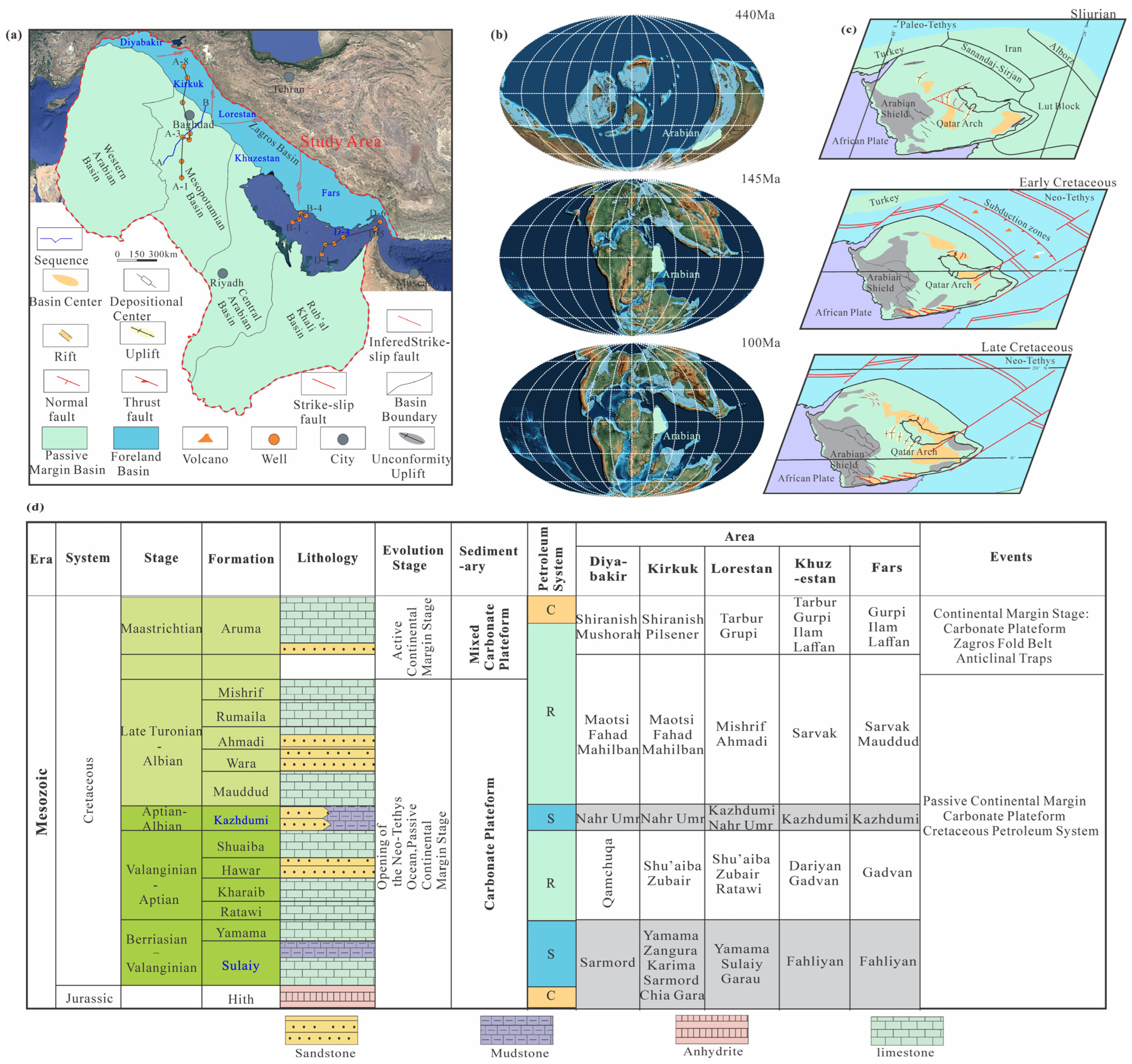

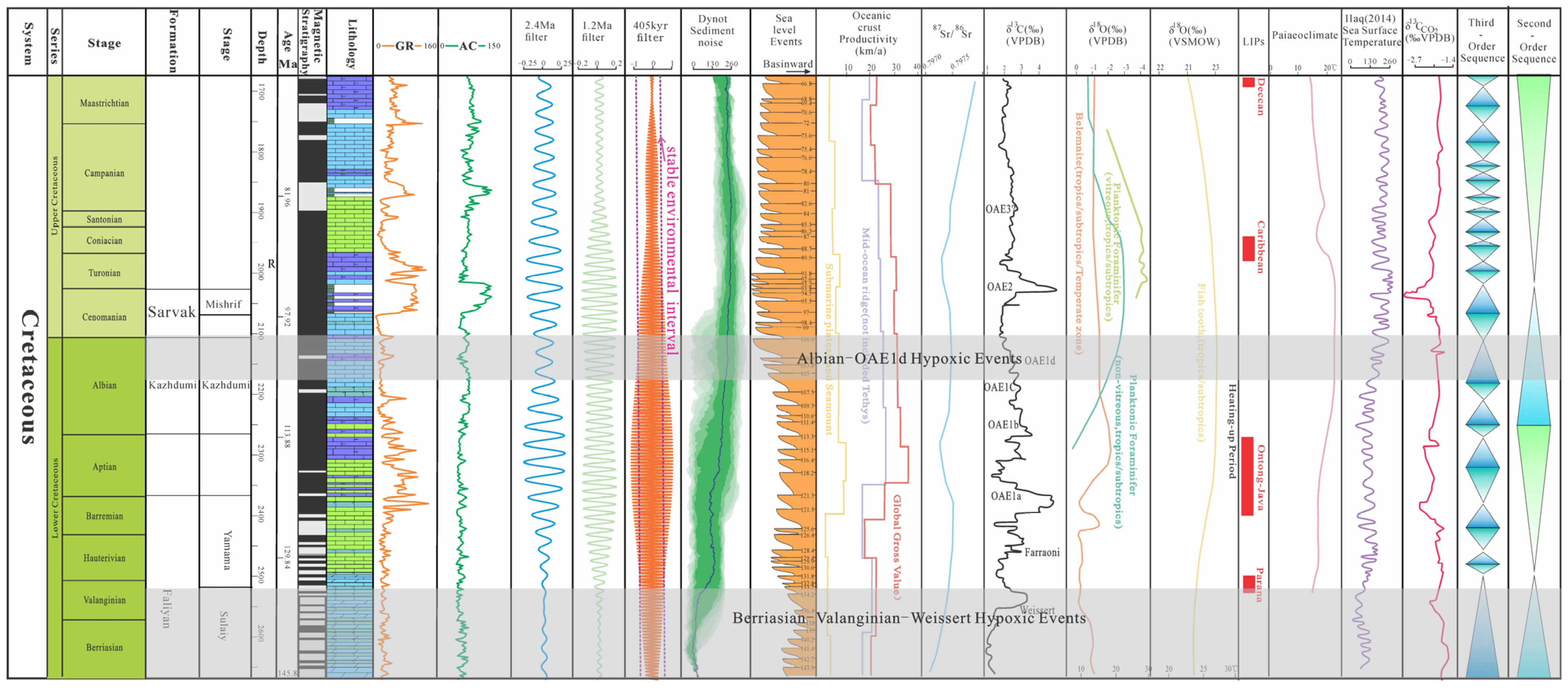
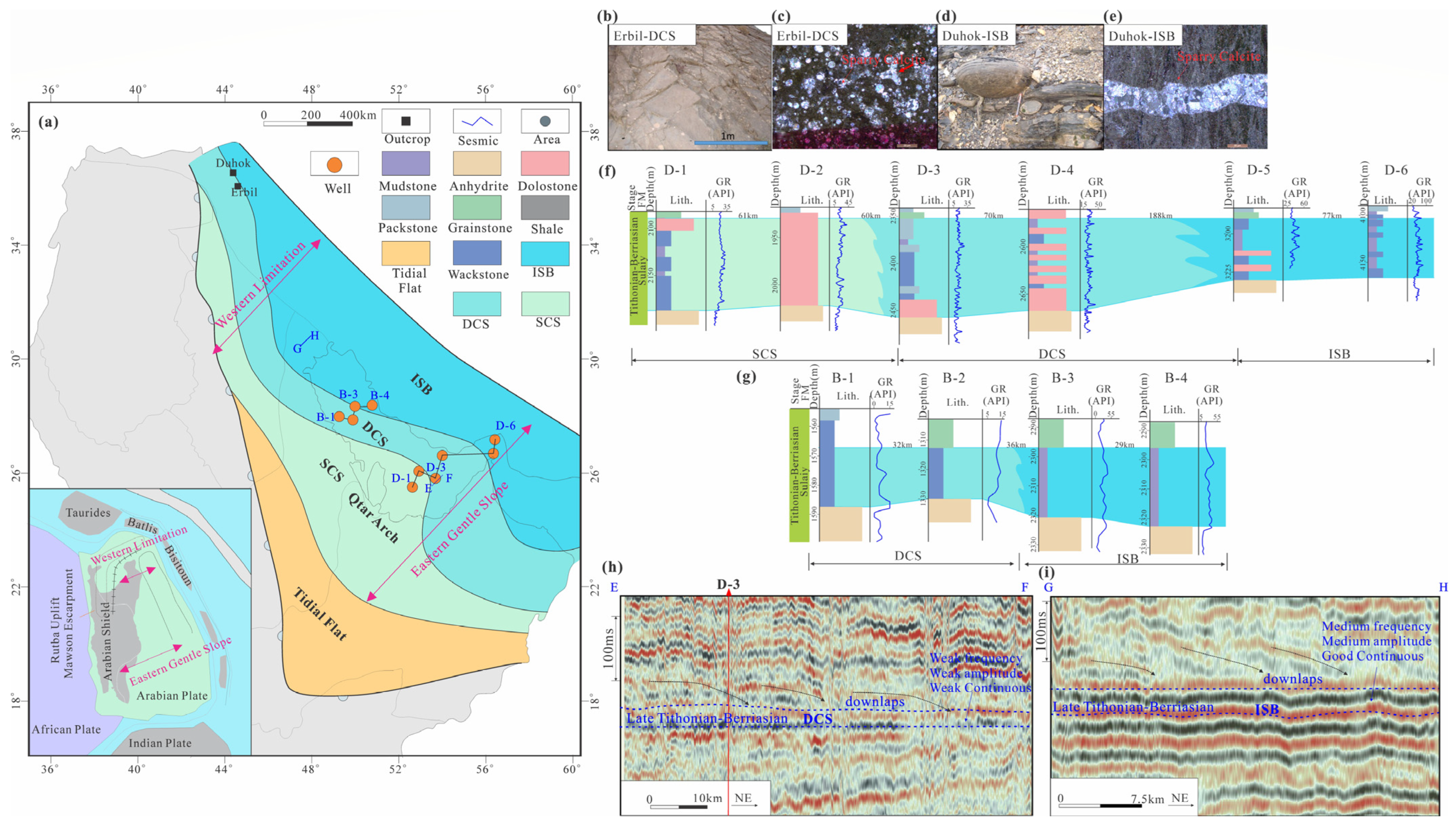
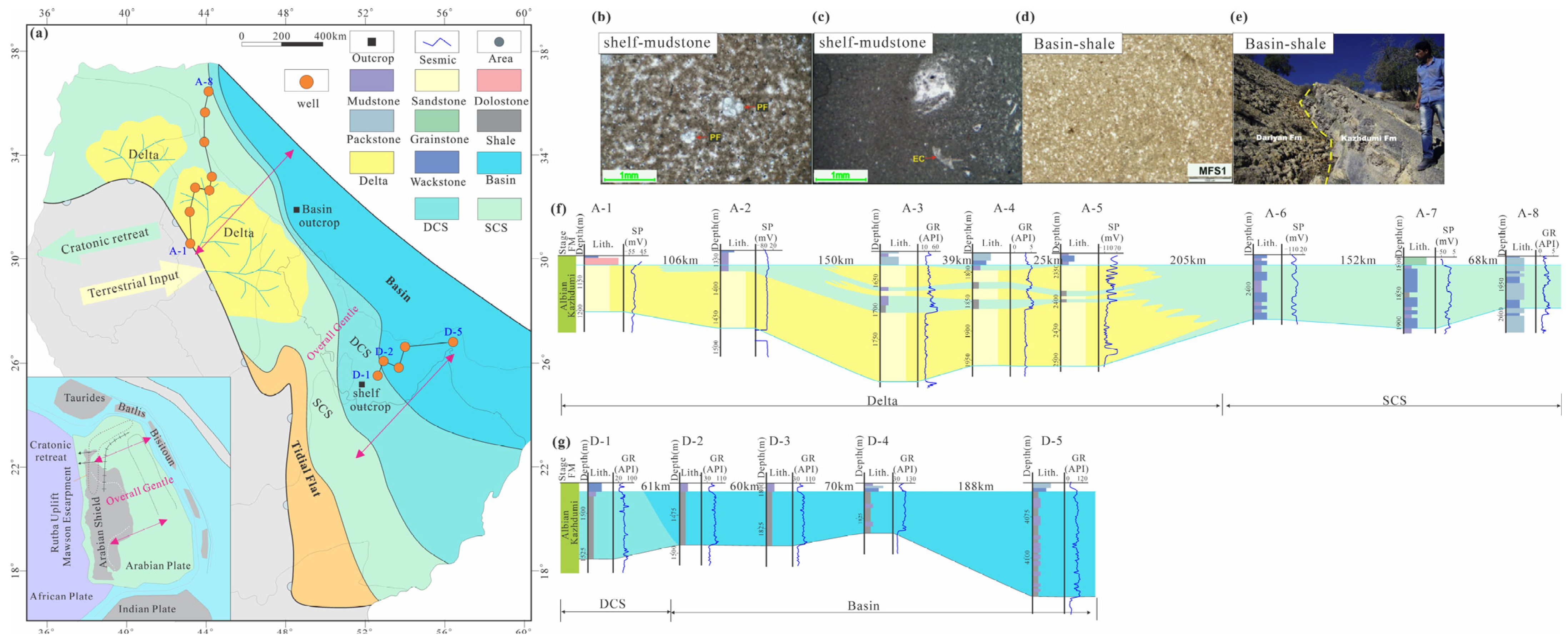

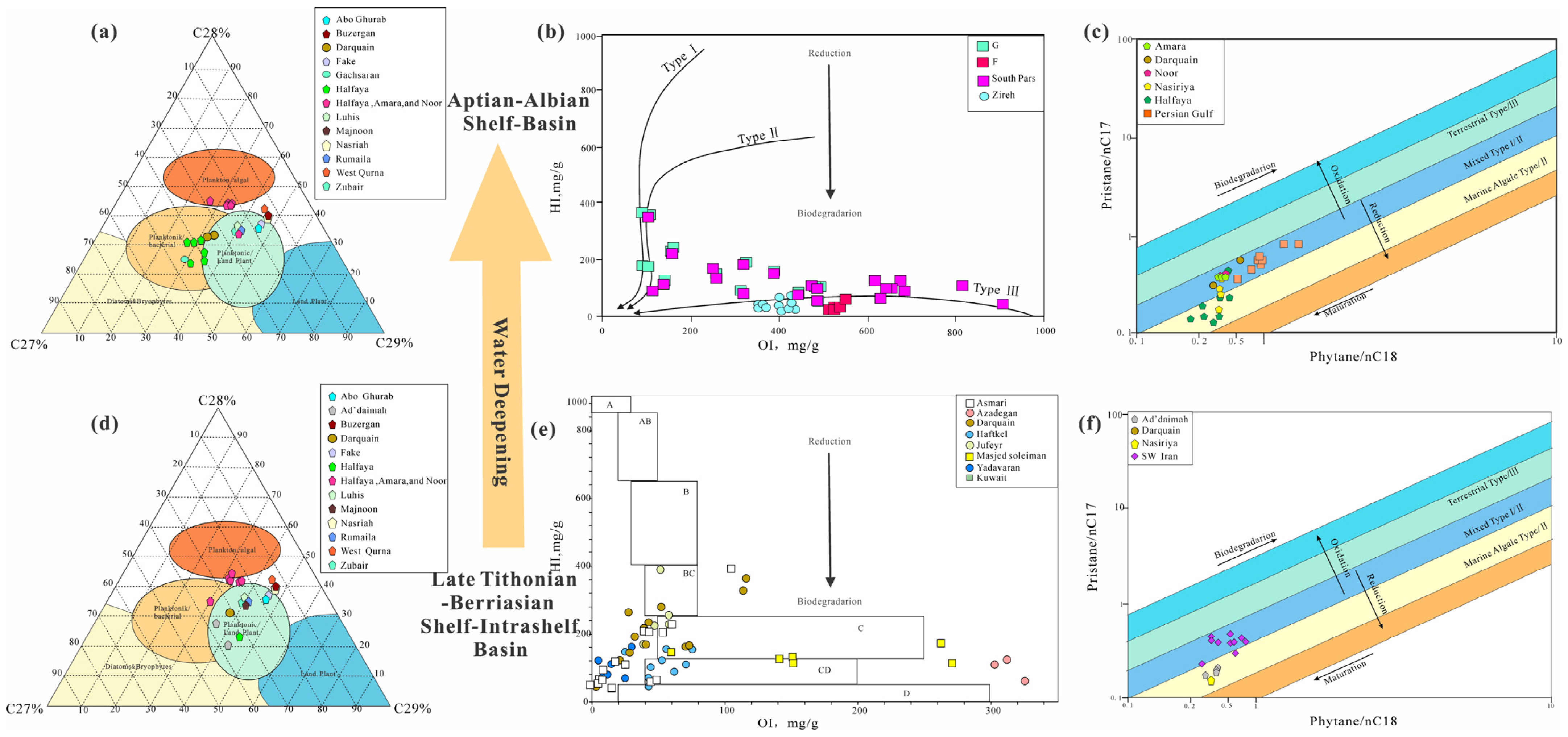


Disclaimer/Publisher’s Note: The statements, opinions and data contained in all publications are solely those of the individual author(s) and contributor(s) and not of MDPI and/or the editor(s). MDPI and/or the editor(s) disclaim responsibility for any injury to people or property resulting from any ideas, methods, instructions or products referred to in the content. |
© 2025 by the authors. Licensee MDPI, Basel, Switzerland. This article is an open access article distributed under the terms and conditions of the Creative Commons Attribution (CC BY) license (https://creativecommons.org/licenses/by/4.0/).
Share and Cite
Wang, Y.; Huang, W.; Cheng, T.; Chen, X.; Cong, Q.; Liang, J. Facies-Controlled Sedimentary Distribution and Hydrocarbon Control of Lower Cretaceous Source Rocks in the Northern Persian Gulf. J. Mar. Sci. Eng. 2025, 13, 576. https://doi.org/10.3390/jmse13030576
Wang Y, Huang W, Cheng T, Chen X, Cong Q, Liang J. Facies-Controlled Sedimentary Distribution and Hydrocarbon Control of Lower Cretaceous Source Rocks in the Northern Persian Gulf. Journal of Marine Science and Engineering. 2025; 13(3):576. https://doi.org/10.3390/jmse13030576
Chicago/Turabian StyleWang, Yaning, Wei Huang, Tao Cheng, Xuan Chen, Qinqin Cong, and Jianhao Liang. 2025. "Facies-Controlled Sedimentary Distribution and Hydrocarbon Control of Lower Cretaceous Source Rocks in the Northern Persian Gulf" Journal of Marine Science and Engineering 13, no. 3: 576. https://doi.org/10.3390/jmse13030576
APA StyleWang, Y., Huang, W., Cheng, T., Chen, X., Cong, Q., & Liang, J. (2025). Facies-Controlled Sedimentary Distribution and Hydrocarbon Control of Lower Cretaceous Source Rocks in the Northern Persian Gulf. Journal of Marine Science and Engineering, 13(3), 576. https://doi.org/10.3390/jmse13030576





